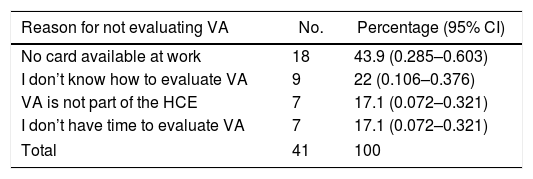The red reflex examination (RRE) and visual acuity testing (VA) is a mandatory part of the examination during the well-child visits (WCV) in primary health care centres of the public system of health in Chile. The eye examination is aimed at the early detection of severe eye diseases in children, such as retinoblastoma, congenital cataracts, and amblyopia. The knowledge and difficulties experienced by health workers in primary care health centres for evaluating the red reflex during WCV in Chile is unknown.
Material and methodsA survey was performed in primary community health centres of XXX Santiago de Chile.
ResultsThe WCV were mainly performed by physicians (45.2%) and nurses (35.8%). Only 34% of health workers performed the red reflex test, and 42.3% checked VA during the WCV. The main reasons for not doing it include the lack of direct ophthalmoscopes and VA charts (55.2% and 43.9%, respectively) at their centres, and not having the knowledge or skills (29.3% and 22%, respectively) to properly perform these clinical tests.
ConclusionIn this series, the eye examination of children attending WCV was unfrequently performed. A better implementation of the health centres and training of the health workers are needed in order to improve the access and quality of the paediatric eye examination in primary health care institutions in Chile.
El examen del rojo pupilar y la estimación de la agudeza visual durante el control del niño sano (CNS) en atención primaria en salud (APS) en Chile representan la mejor oportunidad para pesquisar y tratar precozmente la enfermedad oftalmológica grave, como el retinoblastoma y la ambliopía. El examen oftalmológico forma parte obligatoria de las normas técnicas del Ministerio de Salud para el CNS, sin embargo se desconoce el nivel de conocimiento y la frecuencia con la que los profesionales de la salud realizan el examen oftalmológico durante el CNS, así como las dificultades que enfrentan para realizarlo en APS.
Material y métodosMediante encuestas a profesionales de la salud que realizan CNS en centros de APS del área xxx de Santiago de Chile se investigó la frecuencia con que realizan el examen oftalmológico de los niños y los problemas a los que se enfrentan para realizarlo apropiadamente.
ResultadosCiento treinta y siete profesionales respondieron la encuesta, correspondiendo mayoritariamente a médicos (45,2%) y enfermeras (35,8%). El examen del rojo pupilar y la estimación de la agudeza visual se realizaba con baja frecuencia (34% y 42,3%, respectivamente), siendo las principales causas para no hacerlo la falta de implementos para realizar los exámenes (55,2% y 43,9%, respectivamente) y la falta de capacitación (29,3% y 22%, respectivamente).
ConclusiónEn esta serie el examen oftalmológico se realizó infrecuentemente durante el CNS, requiriéndose mejor implementación y capacitación en el nivel de APS para mejorar la cobertura y calidad en beneficio de la salud visual de la población pediátrica de nuestro país.









